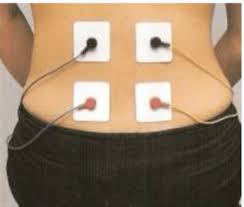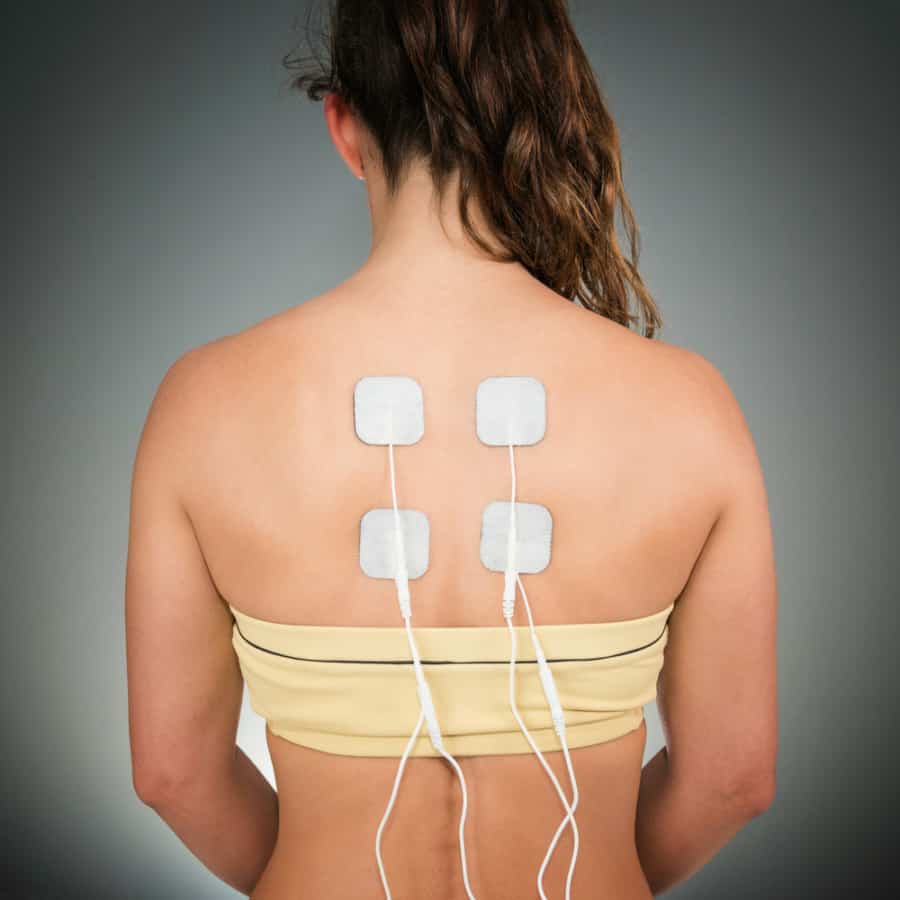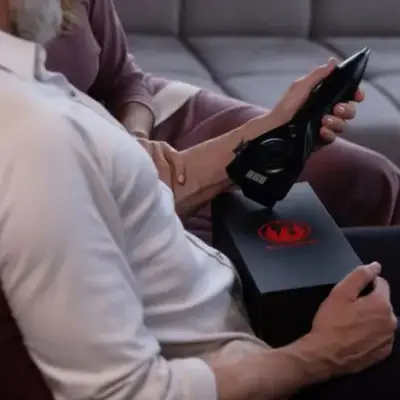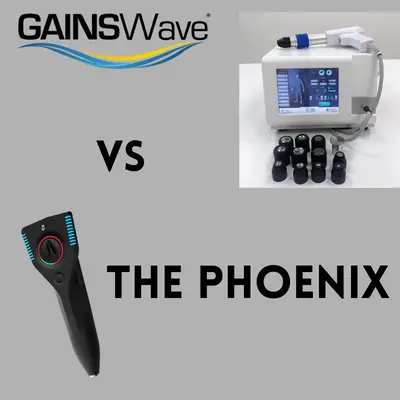Because about 80% of Americans will experience lower back at some point in their lives, shoppers need to stay aware of potential pain relief options. Transcutaneous electrical nerve stimulation (TENS) could be an effective, drug-free solution. But the question remains: How effective are TENS units?
The effectiveness of a TENS unit for back pain is exceptionally variable. Some may experience immediate, soothing pain relief while others may not notice any change in sensation or pain level. Still, TENS-based pain reduction has been met with an overwhelmingly positive response.
This article will explore TENS units, how they work, and how effective they are at reducing back pain. We’ll also prepare you to find the best and most effective TENS unit for back pain so that you can face the browsing list with a sense of confidence and calm.
What Is a TENS Unit?
A TENS unit is a small, handheld electronic device that emits electrical signals. Though there are hundreds of different models and types to choose from, all TENS units follow a similar structure and design. For example, most TENS units are a combination of two essential components:
- The electrode pads
- The control unit
While these components might vary in size, shape, or color, their function remains the same, no matter what model you’re working with. Neither part can fully function without the other, and when you put them together, you get a technological and medical marvel.
The Electrode Pads
TENS unit electrode pads come in many sizes, and they tend to resemble bandages, though they can be any color. Each electrode pad has a connector port that allows lead cables to attach and provide a live electrical current. Of course, this cable wouldn’t be able to supply any power to the electrode pads if they weren’t also attached to the control unit.
It’s crucial to note that wireless TENS units function slightly differently than wired ones, but each model tends to feature a customized pad set-up that differs from its competitors. This considerable variance makes it difficult to sum-up the types of electrode pads included with wireless sets.
Want to know how high you can set a TENS Unit? Check out my article here.
Common TENS Unit Placements for Back Pain


The Control Unit
A TENS unit control unit is many things. It’s the brain of the unit, it’s the heart of the unit, and it’s also the main body of the unit. The control unit often contains the battery, the display screen, the adapter input ports, and the selection buttons.
Most users will spend the majority of their time during a season working with the control unit, not the electrode pads. The control unit powers the electrode pads, sending signals via the lead cables. As you can see, neither component can survive without the other.
How Does a TENS Unit Work?
Every TENS unit follows a similar functional flow. Once you’ve learned how to use one model, you’ll have a reasonably excellent grip on others. While wireless models offer a slightly different version of the following steps, most units require users to:
- Attach the necessary electrode pads.
- Connect the lead cables to the pads.
- Plug the cable adapters into the control unit.
- Turn the control unit on
- Use the buttons or touchscreen to adjust your desired settings.
- The TENS unit will begin to send out waves of electrical impulses.
If you’re unfamiliar with TENS units, this step-by-step breakdown might seem confusing or difficult to comprehend. So, let’s take a close look at each of these steps.
Attach
Before you turn on the control unit or connect any cables, you’ll need to find and gather your electrode pads. You can use as many as you’d like, as long as you’re not overlapping any pads. Still, most individuals with back pain use a single large-sized electrode pad or four small-sizes pads for the most effective pain relief.
It’s essential to use the pads on clean, dry skin. If you’ve been sweating or cooking with oils, you may want to bathe or simply wash and dry the area you intend to treat. Once you have your pads nearby and your skin is prepared to accept the pad adhesive, it’s time to peel the thin plastic bottom off the selected pads.
Resist the urge to toss these bits of plastic film into the garbage can. They will become useful when your session has finished. It may be a good idea to place them in a safe area far from any drafts, breezes, or wind. After revealing the adhesive bottom, place the pads above or below the sides of your troubled region.
Do not place electrode pads directly onto a bruise, open wound, or sore muscle. Doing so will likely only cause more trauma and pain. Included placement guides can help you avoid simple placement mistakes.
And when the electrode pads are secure and properly placed, it is time to get connected.
Connect
Every wired TENS unit comes with a pair of cables. These attach to the electrodes and the control unit, acting as tiny powerlines that transmit electricity between the two components. However, it’s important to point out that not all cables have the same type of connector.
There are three types of TENS electrode pad connection points. They are:
- Snap connector
- Pigtail connector
- Universal connector
Pigtail connectors are incredibly standard, but universal connectors may be the better option in the long run. You never know when you might find an irresistible deal on electrode pads with an incompatible connector type.
After connecting the cable to the pads, you’ll need to plug the other end of the cable into the control unit.
Plug
At the bottom end of each lead cable is a small metal adapter that fits neatly into the control unit’s channel input. Simply push the adapter into the input slot, and prepare to turn the TENS unit on.
Turn
The power button on a TENS unit is a mischievous thing. Depending on the model that you’re using, it could be located at the tip of the device, on the side, somewhere in the middle, or you may even need to touch the screen to power it up.
No matter how your specific device turns on, now is the time to go ahead and flip that switch (so to speak).
Use
At this point, you should have the electrode pads correctly attached, the cables securely connected, and the TENS control unit should be powered on. Now is the time to use your device’s selection buttons or touch screen menus to select, adjust, and confirm various settings.
Most TENS units will offer a standard assortment of flexible options, including program setting, intensity level, and timer amount. Whenever you are satisfied with your chosen settings, simply sit back and enjoy.
Enjoy
After hitting the ‘set’ or ‘start’ button on your device, the TENS unit should immediately spring into action to reduce your level of back pain. Positioning the electrode pads in a plus-sign or cross-like pattern around the tender area is the best way to enjoy a useful pain-relieving experience.
Are TENS Units Dangerous?
While TENS units pose no threat to the standard person, they can become dangerous instruments when misused. Also, individuals with certain pre-existing conditions or ailments may want to avoid seeking TENS treatment.
In other cases, sensitive individuals, such as expectant mothers, may want to consult with their physician or health care provider before pursuing a TENS unit therapy. Still, handheld TENS devices are designed to be incredibly safe.
Individuals who should not use TENS units include:
● Those with heart conditions.
● Individuals with pacemakers.
● Epileptic individuals.
While this guideline may seem a little harsh, it exists for an excellent reason. The electrical signals emitted by a TENS unit can cause seizures in epileptic individuals. And because the heart is an electrically-controlled muscle, TENS stimulation could interfere with normal heart rhythm, causing significant bodily discomfort and harm.
Of course, pacemakers are also electronic devices, and they can easily malfunction due to interference from a TENS unit. If you’re a perfectly healthy adult, and none of the above restrictions apply to you, you should still exercise caution when using a TENS device.
For example, there are a few regions around the body that should never experience direct TENS therapy.
Poor Placement Areas
Applying electrode pads to your lower back, thighs, feet, or lower abdomen is reasonably standard and not very dangerous. A few of these areas are excellent options for electrode pad placement. But it’s equally important to recognize which parts are off-limits for placement.
No one, for any reason, should ever attach a standard TENS unit electrode pad to their:
- Eyes
- Mouth
- Ears
- Neck
- Chest
- Genitals
- Forehead
Generally, it’s never a good idea to place electrodes above your shoulders. It’s also a bad idea to put an electrode pad directly over your heart. Even if you have a perfectly healthy heart, the clash of electric signals could be disastrous.
Placing electrodes on the eyes can cause blindness, just as putting them on the ears can cause premature deafness and inner ear injury. The best way to avoid these awful experiences is to stay aware of safety guidelines and to keep the operating manual handy at all times.
Can a TENS Unit Alleviate Back Pain?
Yes, a TENS unit can potentially help alleviate back pain. TENS devices are already a reasonably popular option for those with lower back pain.
How Does a TENS Unit Reduce Pain?
This question is currently impossible to definitively answer. That’s because the scientific and medical communities have yet to agree on, or discover, the process by which TENS units produce pain-relieving effects.
To put it more plainly: No one knows how TENS units reduce pain.
Still, two competing theories could help explain this phenomenon. They are the Gate Control Theory and the Endorphin Release Theory. While both have influential proponents and supporters, the Gate Control Theory seems to be slightly more widespread and accepted.
The Gate Control Theory
This theory builds upon the fact that large nerve fibers have a fantastic influence on our sense of perception. If you stimulate these fibers, they, in turn, send an overload of sensory information to the brain. The basic concept behind this theory purports that overstimulation helps block lesser pain signals.
To make this theory a little easier to understand (and way more fun to think about), you can imagine that your spinal column is a massive superhighway. At the top of this seemingly infinite and intricate webbing of roads and connections, is the brain. It’s the city where all of the neurons, the electrical messengers that deliver information across this superhighway, live.
However, the neurons are incredibly busy and fantastically fast. They zip along the central spinal superhighway until they reach their most efficient exit. When you decide to shut down those exits, signals may struggle to reach the brain.
The Gate Control Theory suggests that the electrical impulses emitted by TENS units and devices are strong enough to close the ‘nerve gates’ along the spinal column, resulting in a reduced perception of pain.
The Endorphin Release Theory
The Endorphin Release Theory is far different from the Gate Control Theory. This one has virtually nothing to do with nerves, neurons, or interactivity among the internal electrical systems and external stimuli. Instead, it focuses primarily on hormones.
This theory supports the idea that TENS therapy somehow activates the body to produce and release an enormous amount of pain-killing endorphins. How it does this, or why, isn’t addressed in this theory. But this isn’t a wrong guess at how TENS can generate such rapid, temporary, and relieving pain reduction.
After all, endorphins are incredibly powerful all-natural drugs that can completely alter a person’s perception.
Want to know where a TENS unit can be placed? Check out my TENS placement guide here.
The Bottom Line
There is no definitive proof to support either of these theories. While the Gate Control Theory is typically held in slightly higher regard, that doesn’t make it any more accurate than it’s opposition. These theories may even work in tandem.
The gate-closing electrical signals may replicate the initial stages of the typical stress response, allowing a massive amount of endorphin to enter the bloodstream. For all we know, these functions could be causal ones that still fail to address precisely how and why a TENS unit can provide instant pain relief.
For now, the exact mechanism behind a TENS unit’s effects remains a mystery. There are no clear answers as to how these devices provide pain relief. But that makes it difficult to determine why some people report fantastic relief, and others aren’t affected by them.
What Other Conditions Can a TENS Unit Help With?
TENS units are built to provide pain relief. As such, they could make excellent home devices for any person who experiences consistent pain throughout their day. While a TENS unit may be able to lessen the painful symptoms of nearly any condition or ailment, these devices are often used to reduce pain levels in those with:
- Arthritis
- Bursitis
- Labor pains
- Fibromyalgia
- Tendonitis
- Postoperative care
However, TENS units are still being studied. Their full potential is not yet available, because we’re still struggling to understand how it works. Our technological and medical understanding may take many years or decades to catch up with this device. However, when it comes to the future of TENS units, everything looks bright.
What Features Should You Look for When Browsing TENS Units for Back Pain?
While investigating the effectiveness of a TENS unit for back pain, it was necessary to browse hundreds of recent models and discover what features make them more or less effective at treating pain.
Overall, several aspects play into the overall effectiveness of a TENS unit. They include:
- Battery Type
- Wiring Type
- Channels
- Intensity Levels
- Included Materials
While several other minute features may contribute to a device’s power or intensity, these are the traits that best define TENS units that may effectively reduce back pain.
Battery Type
TENS units contain one of two different types of batteries. They can include lithium batteries, or they can house replaceable store-bought cells. Each type of unit exhibits distinct advantages and disadvantages. However, one is far more wallet-friendly than the other.
Rechargeable
Rechargeable TENS units have some evident advantages. Firstly, owners won’t have to continually go out for more batteries when the unit’s power begins to fail. Secondly, most rechargeable TENS devices weigh about a pound, sometimes less.
Because these units contain small, disc-like lithium batteries, their overall weight is immediately several ounces lighter than that of a traditional non-rechargeable model. And because rechargeable models no longer have to sacrifice so much space for a battery compartment, they typically feature far more programs than their traditional counterparts.
Also, these units are capable of storing and outputting massive amounts of energy. Consequently, rechargeable TENS devices usually have bright, backlit screens and a more extensive range of intensity options.
However, this type of TENS unit does have a fatal flaw. When compared to non-rechargeable models, the lithium-powered ones always die first. That’s because the internal battery has a set lifespan. After a certain amount of use, it simply won’t accept or hold a charge.
While it typically takes one of these batteries for about two to three years to finally degrade, this means that owners of rechargeable TENS devices will need to invest in a brand new unit every few years.
When you compare that cost to the cost of replacement batteries over the same timespan, the non-rechargeable option always wins.
Non-Rechargeable
The more traditional TENS unit is the non-rechargeable model. It requires some type of cell battery, though the type and amount differ from device to device. As stated above, this type of TENS unit is the most affordable. This applies to not only the long-term ownership and maintenance costs but also the initial investment price.
Overall, these units tend to be exceptionally practical and very light on features. Most have some form of automatic shut off to help conserve battery life. Also, many of these traditional TENS units last for months on a single charge. This ensures that the device can output an effective range, amount, and intensity of electrical stimulation.
Wiring Type
TENS units come in two different wiring varieties. Some wireless models function via rechargeable batteries and hi-tech sensors. Alternately, there are wired TENS units that work just as effectively, though they can be a little cumbersome.
Wireless
Wireless TENS units are impressive. They’re often incredibly lightweight and portable, and they typically feature a rechargeable battery. Overall, you couldn’t hope for a more convenient TENS device than a modern wireless unit.
Still, even these fantastic pieces of machinery have a few flaws. Wireless models are doomed to slightly shorter lifespans. Because they consume more power than a traditional, non-rechargeable model, they contain lithium batteries.
While these batteries may hold up to repeated use for two or three years, after that point, they’ll likely be unable to accept a charge, rendering the entire control unit useless. However, if you’re determined never to change the batteries in your new TENS unit, a wireless model may be the better choice.
Wired
Standard TENS units are typically wired. They have lead cables that connect the electrode pads to the control unit. While this option ensures that won’t be charging receiver adapters and excess electronics, it could be an awkward choice for naturally clumsy individuals.
Though the length of TENS cable leads has increased over time, allowing for an excellent range of motion and movement, those who decide to wear the unit above their clothing may experience some issues. The cable can quickly become caught on any number of things, which could place the user in a hazardous situation.
You can avoid most of the pitfalls associated with these devices by following proper safety protocol and referring to the manufacturer guidelines. Choosing to wear the unit beneath loose, comfortable clothing is an excellent option.
A notable benefit of choosing a wired TENS unit is its price. Wired models don’t tend to cost as much as wireless ones, and the cost for upkeep is often lower. The wireless adapters and receivers used in wireless systems can be expensive, and if the unit fails within a couple of years, that’s quite a lot of wasted money.
Channels
A TENS unit may have one or more channels, and the number of channels a unit has directly influenced functionality. For example, you could choose to plug a large-sized electrode into one channel, and a small-sized pair of electrodes into a second channel. By placing these pads on various trouble areas across the body, you’d be able to concurrently experience multiple TENS therapies.
Generally speaking, the more channels a TENS unit has, the more capable it is. Quad-channel units, for example, can power up to eight pads at the same time. That’s a fantastic amount of pain-relieving coverage.
Intensity Levels
Nearly all TENS units feature an adjustable intensity level. Depending on the model, the unit may allow the user to adjust the intensity level for each channel, resulting in a fully-customized pain relief experience. You can always opt for a low-intensity TENS therapy program if you’re experiencing a low level of chronic back pain.
However, in cases of intense, acute pain, the intensity level can be raised to help administer a more powerful and effective therapy. But repeated long-term exposure to high-intensity treatment may result in sore, inflamed muscle tissue. Consequently, users should use caution when maxing-out intensity levels, and should always defer to the operating guide for assistance.
Included Materials
Included materials might mean carrying cases, electrode pads, pad cases, or tote bags. TENS kits always include a surplus of materials. Some of these materials are fantastically functional, but some may be relatively useless.
Either way, nearly all TENS units come with everything needed to use the device or system immediately. Most TENS kits will include at least two adhesive electrode pads, if not several more. Every TENS unit should contain the following materials:
- At least two ready-to-use electrode pads
- Lead cables for the electrode pads
- Batteries or a charging cable
Anything included with a TENS kit that falls outside of these three materials is a bonus item. While bonus items can be fun and just as practical as necessary items, you don’t need them. Shoppers looking to save a little dough may want to focus on the basics, like pads, cables, and batteries.
Conclusion
Those suffering from back pain may enjoy owning a TENS unit, though not all users will experience the same level of relief. As of yet, TENS therapies are not universally effective, and some users may feel disappointed after trying this type of stimulating treatment. Still, the majority of people who have attempted TENS for pain relief have reported a little positive change.
If you’re willing to combine low-risk medication, a healthy lifestyle, and a balanced diet with TENS unit therapy, you’ll likely experience the most intense positive effects and benefits of the system. This option could also help you to lessen any dependence on pharmaceutical products gradually.
Overall, individuals with back pain have nothing to lose when trying TENS therapy. Unless, of course, they have a pre-existing condition that precludes them from using a TENS machine.
Sources
- iReliev: Electrode Pads page
- iReliev: Premium TENS + EMS Pain Relief & Recovery
- iReliev: Premium TENS + EMS Therapeutic Wearable System
- Medscape: What is the prevalence of low back pain (LBP)?
- MedicalNewsToday: When to avoid TENS
- myDr.com.au: TENS – transcutaneous electrical nerve stimulation
- Spine-health: Transcutaneous Electrical Nerve Stimulators (TENS)
- The University of Iowa: Transcutaneous electrical nerve stimulator (TENS)
- Wikipedia: Endorphins
- Wikipedia: Transcutaneous electrical nerve stimulation





4 responses to “TENS Unit Review for Back Pain: Is It Effective?”
[…] to know how to use a TENS unit for back pain? Click here to learn […]
[…] to know how to use a TENS unit for back pain? Click here to learn […]
[…] units remain a cost effective option for the management of low back pain. With its easy-to-use design, this device is sure to become a household product for alternative […]
[…] It is advised that you do not begin using a TENS unit until a medical professional is able to diagnose the source of the pain. […]